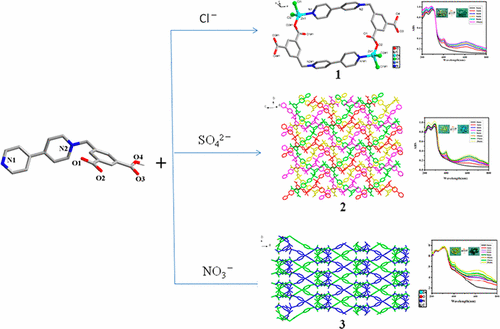当前位置:
X-MOL 学术
›
Cryst. Growth Des.
›
论文详情
Our official English website, www.x-mol.net, welcomes your feedback! (Note: you will need to create a separate account there.)
Photochromic Properties of a Series of Zinc(II)–Viologen Complexes with Structural Regulation by Anions
Crystal Growth & Design ( IF 3.8 ) Pub Date : 2017-11-02 00:00:00 , DOI: 10.1021/acs.cgd.7b00995 Hai-Yang Li 1 , Jing Xu 1 , Lin-Ke Li 1 , Xiang-Sha Du 1 , Fu-An Li 2 , Hong Xu 1 , Shuang-Quan Zang 1
Crystal Growth & Design ( IF 3.8 ) Pub Date : 2017-11-02 00:00:00 , DOI: 10.1021/acs.cgd.7b00995 Hai-Yang Li 1 , Jing Xu 1 , Lin-Ke Li 1 , Xiang-Sha Du 1 , Fu-An Li 2 , Hong Xu 1 , Shuang-Quan Zang 1
Affiliation

|
The solvothermal reaction of 1-(3,5-dicarboxybenzyl)-4,4′-bipyridinium chloride (H2L+Cl–) with different anionic Zn(II) salts leads to three diverse metal–viologen complexes, formulated as {[Zn(HL)Cl2]2·2H2O} (1), {[Zn3(L)2(H2O)8]·2(SO4)·2(H2O)}n (2), and {[Zn(L)H2O]·NO3·H2O}n (3). Single-crystal X-ray analyses revealed that complex 1 displays dinuclear structure. Complex 2 features a 2D layered structure, which consists of four-fold interpenetrating stacked layers with sulfate ions locating between the sheets. Complex 3 shows a 3D two-fold interpenetrating framework with nitrate anions interspersing the void space of the framework, and it features an uninodal three-connected ThSi2 (ths) topology. The structural disparities reveal that the different geometries of counterions, coordination modes, and conformations of ligand L–, together with the deprotonation degree of aromatic carboxylate, have great influence on the formation of various structures. Interestingly, complexes 1–3 are all photoactive to UV–visible light and undergo obvious and reversible color transformations from light yellow to blue/green. Structural analyses indicated that not only the carboxylate-O donor and N acceptor of the bipyridinium moiety can provide an effective electron transfer pathway for photochromic behavior, but the Cl → L electron transfer in complex 1 also has a crucial effect on the photochromic behavior of it.
中文翻译:

一系列具有阴离子结构调节作用的锌(II)-紫精配合物的光致变色性质
1-(3,5-二羧基苄基)-4,4'-联吡啶鎓氯化物(H 2 L + Cl –)与不同的阴离子Zn(II)盐的溶剂热反应产生三种不同的金属-紫精配合物,配制成{ Zn(HL)Cl 2 ] 2 ·2H 2 O}(1),{[Zn 3(L)2(H 2 O)8 ]·2(SO 4)·2(H 2 O)} n(2) ,和{[Zn(L)H 2 O]·NO 3 ·H 2 O} n(3)。单晶X射线分析表明,复合物1显示出双核结构。配合物2具有2D分层结构,该结构由四层互穿的堆叠层组成,其中硫酸根离子位于两张纸之间。配合物3显示了3D互穿的2D骨架,其中硝酸根阴离子散布在骨架的空隙中,并且具有单节三连接的ThSi 2(ths)拓扑结构。结构上的差异显示,抗衡离子的几何形状,配位模式和配体L –的构象不同与芳族羧酸盐的去质子度一起,对各种结构的形成有很大的影响。有趣的是,复合物1 - 3都是光敏紫外-可见光和经历从浅黄明显的和可逆的颜色转换为蓝色/绿色。结构分析表明,不仅联吡啶鎓部分的羧酸根-O供体和N受体可以为光致变色行为提供有效的电子转移途径,而且配合物1中的Cl→L电子转移也对其络合物的光致变色行为起关键作用。 。
更新日期:2017-11-02
中文翻译:

一系列具有阴离子结构调节作用的锌(II)-紫精配合物的光致变色性质
1-(3,5-二羧基苄基)-4,4'-联吡啶鎓氯化物(H 2 L + Cl –)与不同的阴离子Zn(II)盐的溶剂热反应产生三种不同的金属-紫精配合物,配制成{ Zn(HL)Cl 2 ] 2 ·2H 2 O}(1),{[Zn 3(L)2(H 2 O)8 ]·2(SO 4)·2(H 2 O)} n(2) ,和{[Zn(L)H 2 O]·NO 3 ·H 2 O} n(3)。单晶X射线分析表明,复合物1显示出双核结构。配合物2具有2D分层结构,该结构由四层互穿的堆叠层组成,其中硫酸根离子位于两张纸之间。配合物3显示了3D互穿的2D骨架,其中硝酸根阴离子散布在骨架的空隙中,并且具有单节三连接的ThSi 2(ths)拓扑结构。结构上的差异显示,抗衡离子的几何形状,配位模式和配体L –的构象不同与芳族羧酸盐的去质子度一起,对各种结构的形成有很大的影响。有趣的是,复合物1 - 3都是光敏紫外-可见光和经历从浅黄明显的和可逆的颜色转换为蓝色/绿色。结构分析表明,不仅联吡啶鎓部分的羧酸根-O供体和N受体可以为光致变色行为提供有效的电子转移途径,而且配合物1中的Cl→L电子转移也对其络合物的光致变色行为起关键作用。 。



























 京公网安备 11010802027423号
京公网安备 11010802027423号